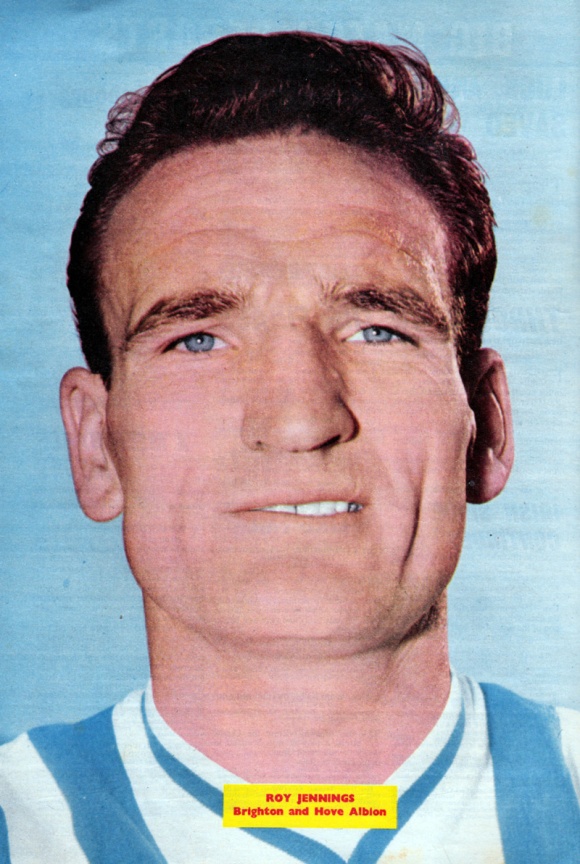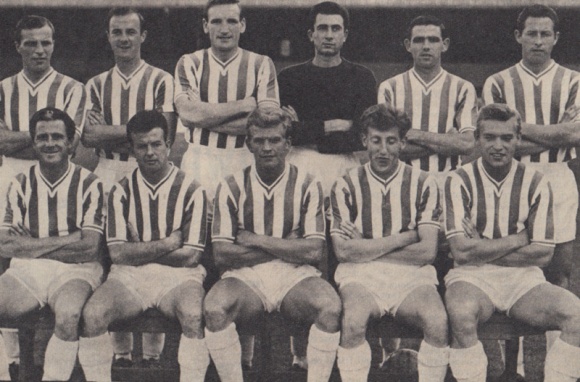Brighton’s first ever match in Division Two was a disaster. It was at Middlesbrough in August 1958 and the Albion were thumped 9-0 with future Brighton manager Brian Clough grabbing five of the goals. The return game at the Goldstone Ground in December saw the Sussex side treated to a 4-6 home defeat. By 1961, the Brighton line-up was much changed, but the club was still competing in the Second Division.
Roy Jennings was the tough-tackling stalwart of the side. In Charles Buchan’s Football Monthly in December 1961, he looked back at the previous few years:
It doesn’t seem three years since Brighton won the old Third Division South championship and promotion to the Second Division. Yet we are now in our fourth season as a Second Division club – and I am the only survivor of the side which won a championship medal in 1958.
True, Steve Burtenshaw, our regular left-half, was a colleague at that time, but Steve played only occasionally in the League side and did not qualify for a medal.
I made the bare 14 appearances needed to earn a medal. I was mainly a full-back in those days and Brighton were well off in that department. All the other stalwarts of our Third Division days have moved on… Jim Langley, Eric Gill, Glen Wilson, Denis Gordon, Peter Harburn, Frankie Howard and co.
There have been other changes in my time at Goldstone Road. A new stand to replace the rickety old construction which did duty as the main building for too many years; new dressing rooms; floodlighting.
Mr Billy Lane, who steered us to promotion and whose powers of persuasion had so much to do with my joining Brighton, has also gone. The place doesn’t seem the same without him although I feel sure that his successor, George Curtis, from Sunderland, is going to do a great job for us.
When we won promotion some people said we would be out of our depth in the Second Division. When we took two early beatings from Middlesbrough it seemed as though the critics were right.
But we recovered and more than held our place in the higher grade.
The Second Division is the toughest one from which to gain promotion. Each season there seem to be about four top-class sides challenging, with the rest cutting each other’s throats week by week.
For the last three years I have been the regular centre-half and now I am club skipper. At school, in my native Swindon, I was a full-back and won England Youth and Wiltshire county honours at the same time as John Atyeo, of Bristol City.
I had no ambition to become a professional footballer. I was keen on accountancy and studied it. I was working as a clerk in a garage when Ted Nash, a local scout, recommended me to Southampton manager George Roughton.
I signed amateur forms for Southampton and played a few games in their reserves before going into the RAF. Then I had a firm offer from Brighton and, in 1952, I signed for them as a full-time professional – and forgot about a career as an accountant.
I was switched to first team centre-half soon after those Middlesbrough defeats I have mentioned. A good game against Tottenham reserves (I managed to blot out Dave Dunmore) earned me promotion and since then I have held my place. Only twice have I missed a match through injury.
One of my most memorable games in our first season in the Second Division was a Boxing Day meeting with the then League leaders, Fulham, in 1958. Their visit drew a record Goldstone Road crowd of 36,747, with receipts of £4,376.
We beat them 3-0, Johnny Haynes and all, and I shut out centre-forward Maurice Cook out of the game.
A quick thumb through the record books show that on Boxing Day, 1958, Brighton actually lost 3-1 at Craven Cottage. Here is some very ropey footage from the match:
Brighton’s magnificent 3-0 victory over Fulham came on the following day, and was aided by the return of Jimmy Langley. Two Tommy Dixon goals and one by Adrian Thorne beat the eventual Division Two runners-up.
Sadly, after a four-year stay in the Second Division, Brighton finished bottom at the end of 1961/62, the season of this feature in Football Monthly. Albion were relegated, with Jennings’ faith in the managerial ability of George Curtis proving misplaced. Here’s the team photo from the same edition:
In the following season, such was his popularity, that when Jennings was dropped for three games in favour of youngster Norman Gall, Curtis’ decision prompted ‘We Want Jennings’ chants from the Brighton supporters. Roy was then restored.
He was eventually given a free transfer at the end of 1963/64 and joined Crawley Town, where he eventually became player-manager. He had made 297 appearances for Brighton, scoring 22 times (13 of which were from the spot).






